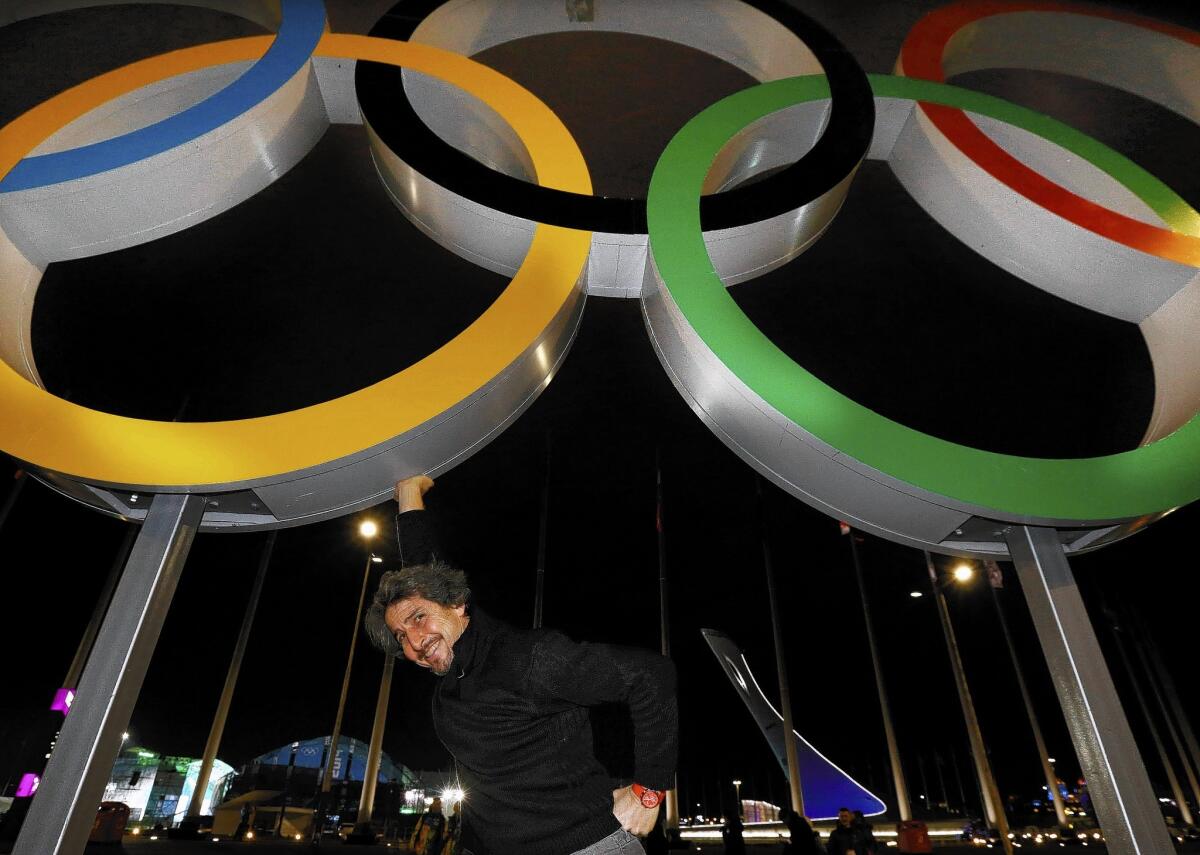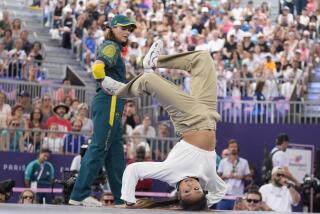Sochi Olympics: American choreographer takes on opening ceremony

SOCHI, Russia — Walking through the Olympic Village on Wednesday, choreographer Daniel Ezralow had to stop intermittently at checkpoints, like everyone. At one, he started singing a popular song from the Soviet era in Russian as he passed through.
“Let there always be...” Ezralow sang, looking invitingly at the Russian guard. The guard beamed back and sang: “sunshine!” Ezralow turned to another guard and sang the next line, again in Russian: “Let there always be ...”
“Blue sky,” the guard sang back happily.
“You see? They understand me and they know the song too,” Ezralow exclaimed. “Let There Always Be Sunshine” is a Russian pop song from the 1960s.
Few of the more than 40,000 spectators in the Olympic Fisht Stadium and millions more around the world watching the opening ceremony on television knew that the core pieces of the show were created and choreographed by an American, Los Angeles native Ezralow.
PHOTOS: Arts and culture in pictures by The Times
A former member of the Paul Taylor Dance company, Ezralow’s work has been seen on the stage and TV, in music video: the Cirque du Soleil Beatles show “Love,” Broadway’s “Spider-Man: Turn Off the Dark,” and in the Julie Taymor film “Across the Universe” that is set to Beatles music. He was an original dancer and choreographer of the contemporary dance company MOMIX, and has also contributed original dances for companies including the Paris Opera Ballet and Hubbard Street Dance in Chicago.
Though he has Russian-Jewish family roots going back to the 20th century Ukraine and Belarus and 19th century Central Asia, working on the opening ceremonies brought Ezralow to Russia for the first time.
Even so, he was entrusted with two long episodes devoted to the 20th century history of Russia, which made up roughly half of the theatrical portion of the ceremonies.
“I said, OK, if it must be Soviet it must also be ironic, clever and joyful,” Ezralow, 57, recalled. “I was born in America and I went through a vision of Cold War and have never been to Russia before and to do it right I needed to eat their food, to talk to the people and try to learn their language.”
PHOTOS: Winter Olympics in film
In the performance Friday, a young girl stood onstage with a little red balloon to the song Ezralow had sung with the Olympic Village guards, in a portion of the program called “Moskva/The Dream,” reflecting the times of political and intellectual thawing in the 1960s after Josef Stalin’s death.
In the culmination of the piece she is suddenly lifted by the balloon and then lets it go, symbolizing the end of the Soviet era filled with pioneers, pilots, cosmonauts and Uncle Styopa, the good cop and household name from children’s poetry played by former world heavyweight boxing champion (and currently Vladimir Putin loyalist) Nikolay Valuyev.
Ezralow dubbed the Russian revolution portion of his contribution to the show “Red Volution.” It started with a stylish reference to Russian avant-garde art and Kazimir Malevich, with huge elements from Malevitch’s paintings flying over the stage. But it quickly turned to the industrialization of the Soviet countries.
“I created a sort of a red world in which there were these tractors which I have peopled with dancers like gears on the machines, which at some moment start working together as a huge hydro-electric plant,” Ezralow said.
CRITICS’ PICKS: What to watch, where to go, what to eat
The stage was swarming with red tractors, which initially appeared to be plowing the earth but then started moving faster and faster. The dancers, clad in red and black costumes, along with the tractors and cogs and gears, were visibly running at the limit of their powers.
Ezralow made his first visit to Russia last August, then worked with a group of U.S. dancers in L.A. for two weeks in October “to play around with ideas and visions.” He moved on to Moscow, where he handpicked a core of 76 dancers to be joined later on by 700 more when Ezralow arrived in Krasnodar, the capital of the region where Sochi is located.
Since Jan. 2, the group has been working for eight or more hours every day, Ezralow said, and at the same time, he watched the Olympic construction come together like “an amazing cartoon.”
“I looked out my hotel window one day — it is all dirt,” he recalled. “I looked the next day and it is a road, and the next day it was all planted. That was truly amazing and very inspiring.”
Ezralow refuses to talk about whether the notorious anti-gay legislation and other human rights violations of the Putin regime should have been valid enough reasons to avoid cooperating in the Games, which many observers are calling the “Triumph of Putin’s Will,” invoking “The Triumph of the Will,” the 1934 propaganda movie about a Nazi Party rally in Nuremberg.
RELATED: How to watch the 2014 Sochi Olympics on TV
“I am not condoning human rights violations but everybody makes mistakes,” he said. “I am not a politician and I am not a revolutionary as I simply want to change the world by inspiring it. Everybody has fear and anger but my job is not to fuel that up. My job is to say: ‘Let’s use the flame of creativity for positivity.’”
Ezralow calls Putin “a very solid man and a very grounded man.” He shook hands with him when the Russian president came to watch a rehearsal.
“I explained to him a little bit of what I was trying to do,” the artist said. “When I was introduced to him as an American choreographer he looked at me and asked: ‘Are you working solo or are you collaborating?’” referring to the Russian members of the show’s creative team. “I said: ‘I am collaborating.’ He said: ‘Fantastic.’”
“In a strange way I feel like Putin does want the country to keep up this forward motion,” Ezralow said. “He wants to keep building. He really senses the forward motion and the need to continue it.”
The audience responded to Ezralow’s work with the loudest cheers of the night. At least one spectator said it was the best piece in the show.
“It was very cool, very big scale,” said Maxim Kazarnovsky, a businessman who specifically flew from Moscow to see the show. “Visually and in terms of choreography it was by far the brightest and most powerful part of the show.”
Kazarnovsky didn’t know it was staged by an American. “Wow,” he said. “Good for him!”
More to Read
The biggest entertainment stories
Get our big stories about Hollywood, film, television, music, arts, culture and more right in your inbox as soon as they publish.
You may occasionally receive promotional content from the Los Angeles Times.










